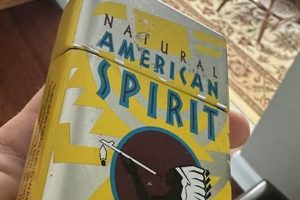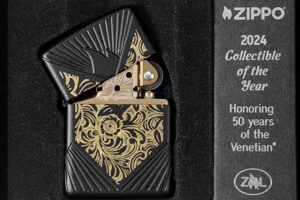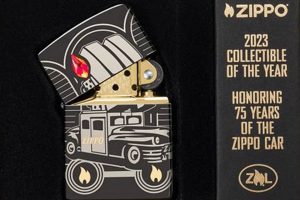Embarking on the journey of accumulating Zippo lighters involves a blend of research, acquisition, and organization. For instance, a novice collector might begin by acquiring a common model, researching its manufacturing date and variations, and then carefully storing it in a protective case. This initial step often sparks a deeper exploration of the diverse world of Zippo manufacturing and design.
Building a curated collection provides a tangible connection to history, design, and craftsmanship. Zippo lighters, with their iconic windproof design and diverse decorative styles, offer a window into evolving aesthetic trends and historical periods. The meticulous documentation and preservation involved in collecting can also foster a deeper appreciation for the manufacturing process and the enduring legacy of these practical and collectible items.
This guide explores the essential aspects of initiating and expanding a Zippo collection, including identifying authentic lighters, understanding variations and value, effective storage and preservation techniques, and navigating the marketplace for buying and selling. Whether one’s focus is on specific eras, designs, or simply appreciating the artistry and functionality, this information will serve as a valuable resource.
Tips for Beginning a Zippo Lighter Collection
Initiating a Zippo collection requires careful consideration of several factors, from establishing a collecting focus to understanding market dynamics. The following tips offer guidance for navigating the initial stages of building a curated collection.
Tip 1: Define Collecting Parameters. Concentrating on a specific theme, era, or design elementsuch as military insignia, advertising themes, or specific finishesprovides focus and prevents overspending on random acquisitions.
Tip 2: Research Thoroughly. Understanding Zippo dating systems, production variations, and genuine versus counterfeit identification is critical for informed purchasing decisions.
Tip 3: Start Small and Gradually Expand. Begin with readily available, less expensive models to gain experience and build a foundation before pursuing rarer or more costly pieces.
Tip 4: Inspect Carefully Before Purchasing. Examine lighters closely for damage, repairs, and authenticity markers. Consult reputable online resources and guides to verify markings and dates.
Tip 5: Establish a Budget and Stick to It. Rare or highly sought-after Zippos can command significant prices. A predetermined budget helps manage expenses and prevents impulsive purchases.
Tip 6: Network with Other Collectors. Online forums, collector clubs, and specialized dealers provide invaluable resources for sharing information, authenticating lighters, and identifying reputable sellers.
Tip 7: Invest in Appropriate Storage. Protective cases, display boxes, and a controlled environment safeguard the collection from damage and preserve its value over time.
By following these guidelines, enthusiasts can build a meaningful and valuable Zippo collection that reflects their interests and appreciation for these iconic lighters.
This foundation provides a solid starting point for further exploration of specific collecting areas, advanced identification techniques, and engagement with the broader Zippo collecting community.
1. Research Thoroughly
Comprehensive research forms the cornerstone of a successful Zippo collection. It provides the necessary knowledge to make informed decisions, avoid costly mistakes, and cultivate a collection of genuine value and historical significance. Without diligent research, collectors risk acquiring counterfeit lighters, misjudging value, or overlooking key details that contribute to a collection’s depth and richness.
- Understanding Manufacturing Dates and Markings
Zippo lighters possess specific markings indicating their production date and factory location. Understanding these markings enables collectors to accurately date their acquisitions and identify potential variations within specific production years. This knowledge is crucial for authentication and establishing a timeline within a collection. For example, a bottom stamp can reveal if a lighter is a wartime model or a later reproduction.
- Identifying Variations and Rarity
Zippo has produced countless designs and limited editions over the decades. Researching these variations, their production numbers, and historical context allows collectors to appreciate the nuances of their collection. Understanding rarity directly impacts value and desirability within the collecting community. A rare design variation can significantly increase a lighter’s worth.
- Recognizing Counterfeit Lighters
The popularity of Zippo lighters has unfortunately led to a proliferation of counterfeits. Researching the telltale signs of fake lightersvariations in case construction, inferior markings, or inconsistent finishesequips collectors with the knowledge to avoid costly purchases of non-genuine items. This safeguards the integrity and value of a collection.
- Determining Fair Market Value
Researching completed sales on online auction platforms, consulting price guides, and engaging with reputable dealers provides insights into the current market value of specific Zippo models. This knowledge empowers collectors to make informed purchasing and selling decisions, maximizing their budget and ensuring fair transactions. Overpaying for a common lighter undermines a collection’s overall value.
These research facets are interconnected and crucial for building a meaningful Zippo collection. A deep understanding of manufacturing processes, design variations, and market dynamics allows collectors to curate a collection that reflects their interests, knowledge, and appreciation for the rich history and craftsmanship of Zippo lighters. By prioritizing research, collectors lay the groundwork for a rewarding and enriching collecting experience.
2. Define Collecting Scope
Defining a collecting scope is paramount when initiating a Zippo collection. A clearly defined scope provides focus, prevents indiscriminate acquisitions, and allows for a more curated and meaningful collection. Without a defined scope, a collection risks becoming a random assortment of lighters lacking coherence and historical significance. Establishing parameters guides acquisition decisions and contributes to a more satisfying collecting experience.
- Era-Specific Collections
Focusing on a specific era, such as wartime Zippos, allows for in-depth exploration of designs and historical context relevant to that period. This approach enables collectors to develop specialized knowledge about manufacturing processes, materials, and social influences of the chosen era. For example, a collection focused on World War II Zippos might include lighters with military insignia, sweetheart designs, or specific markings indicating wartime production. This focused approach provides historical depth and narrative to the collection.
- Theme-Based Collections
Collectors may choose to focus on specific themes, such as advertising, sports teams, or artistic designs. This thematic approach allows for exploration of diverse Zippo designs within a unifying framework. For instance, a collection centered on automotive-themed Zippos might include lighters featuring classic car logos, racing imagery, or advertising from specific automotive brands. This approach showcases the versatility of Zippo designs within a specific area of interest.
- Material or Finish-Specific Collections
Concentrating on specific materials, such as sterling silver or brass, or finishes like high-polish chrome or brushed brass, offers a different collecting perspective. This approach emphasizes the craftsmanship and material variations employed by Zippo throughout its history. For example, a collection focused on brushed chrome Zippos might showcase the evolution of this finish across different decades and designs, highlighting subtle variations in texture and production techniques.
- Limited Edition or Commemorative Collections
Focusing on acquiring limited edition or commemorative Zippos allows collectors to pursue rarer and often more valuable pieces. These lighters often commemorate specific events, historical figures, or popular culture icons. For example, a collection of Harley-Davidson anniversary Zippos showcases the intersection of two iconic American brands and provides a tangible connection to specific milestones in Harley-Davidsons history.
These various approaches to defining collecting scope illustrate the importance of establishing parameters when initiating a Zippo collection. A well-defined scope transforms the collecting process from random acquisition into a focused pursuit of specific historical artifacts, design variations, or thematic narratives. This focus enhances the overall collecting experience and contributes to a more meaningful and valuable collection.
3. Authenticate Lighters
Authentication is crucial when starting a Zippo collection. It ensures the collection’s integrity and value, protecting against the acquisition of counterfeit lighters. A collection comprised of genuine Zippos holds historical significance and potential investment value, while counterfeit inclusions diminish both. Understanding authentication methods equips collectors to make informed purchases and build a collection of verifiable authenticity.
- Bottom Stamp Examination
The bottom stamp provides essential information for authenticating a Zippo lighter. Specific markings denote the manufacturing date and factory location. Variations in font, spacing, and depth of stamping can distinguish genuine Zippos from counterfeits. Comparing a lighter’s bottom stamp to documented examples from reputable sources helps verify its authenticity. A correctly dated bottom stamp corroborates other features, increasing confidence in a lighter’s genuineness.
- Case Construction and Finish
Genuine Zippo lighters exhibit consistent case construction and high-quality finishes. Counterfeits often have irregularities in the case’s metal thickness, hinge construction, or lid fit. Examining the finish for inconsistencies in color, texture, or application can also reveal counterfeits. A genuine Zippo displays a level of craftsmanship and quality often absent in fakes. Careful inspection of these features can prevent the acquisition of inferior reproductions.
- Insert Examination
The insert, the removable internal mechanism of a Zippo lighter, also possesses features that aid authentication. Specific markings on the insert, including the flint wheel and chimney, can indicate a lighter’s authenticity and production period. Counterfeit inserts often use inferior materials and lack the precise construction of genuine Zippo inserts. Careful scrutiny of the insert’s components and markings adds another layer of verification to the authentication process.
- Consulting Reputable Resources
Numerous online resources and printed price guides offer detailed information about Zippo markings, variations, and authentication techniques. Cross-referencing a lighter’s features with information from these trusted sources provides additional validation. Engaging with established Zippo collectors and dealers can also provide expert opinions on a lighter’s authenticity. Leveraging these resources helps avoid costly mistakes and strengthens authentication efforts.
By employing these authentication methods, new collectors safeguard their investment and ensure the historical integrity of their collections. A collection built on verified authenticity provides a solid foundation for further exploration of Zippo’s rich history and diverse designs. Authentication empowers informed decision-making, contributing to a more rewarding and valuable collecting experience. A meticulously authenticated collection holds significantly greater value and historical significance than one containing questionable items.
4. Budget Wisely
Budgeting wisely is fundamental to establishing and maintaining a successful Zippo collection. Uncontrolled spending can quickly deplete resources, leading to financial strain and hindering long-term collecting goals. A well-defined budget provides a framework for making informed purchasing decisions, ensuring that acquisitions align with collecting objectives and available funds. This disciplined approach allows for sustained growth and prevents impulsive purchases that may later be regretted. For example, allocating a specific monthly amount for Zippo acquisitions allows collectors to strategically pursue desired pieces without overspending. A predetermined budget also facilitates prioritization, ensuring that limited funds are directed towards the most desirable or historically significant lighters within a defined collecting scope.
Practical applications of budgeting within Zippo collecting include setting realistic price limits for specific lighter types, researching average market values to avoid overpaying, and allocating funds for ancillary collecting expenses such as storage supplies, display cases, and authentication services. Tracking expenditures against the budget provides valuable insights into spending patterns and allows for adjustments based on collecting priorities. For instance, a collector might decide to forego purchasing a common lighter to save for a rarer, more desirable piece that aligns with their collecting scope. This strategic allocation of resources maximizes the budget’s impact and contributes to a more focused and valuable collection.
In summary, a well-defined budget serves as a critical tool for navigating the Zippo collecting landscape. It provides financial control, informs purchasing decisions, and ensures that the pursuit of collecting remains enjoyable and sustainable. Failing to establish and adhere to a budget can lead to financial difficulties and hinder the long-term growth and development of a meaningful collection. Strategic budgeting empowers collectors to make informed choices, prioritize acquisitions, and maximize the value and historical significance of their collections within defined financial parameters. This approach fosters a sustainable and rewarding collecting experience, preventing financial overextension and promoting thoughtful acquisition strategies.
5. Explore Reputable Sources
Exploring reputable sources is integral to initiating and developing a meaningful Zippo collection. Reliable sources provide crucial information regarding authenticity, historical context, market value, and collecting best practices. This informed approach mitigates the risks associated with acquiring counterfeit lighters, overpaying for common pieces, or mishandling valuable artifacts. For example, consulting established price guides or engaging with recognized Zippo dealers provides insights into fair market values and helps avoid inflated prices. Utilizing reputable online forums dedicated to Zippo collecting connects enthusiasts with experienced collectors who offer valuable advice and authentication assistance. This networking fosters a deeper understanding of the collecting landscape and strengthens the community aspect of the hobby.
Furthermore, reputable sources offer in-depth knowledge about Zippo manufacturing processes, historical periods, design variations, and limited editions. This information enriches the collecting experience, transforming the acquisition process from mere accumulation to a curated exploration of history, design, and craftsmanship. Accessing detailed documentation about specific models, including production dates, factory locations, and design variations, adds historical depth and context to each acquisition. For instance, understanding the historical significance of wartime Zippos or the design evolution of a specific advertising series enhances the collector’s appreciation for these artifacts. This knowledge also contributes to more informed purchasing decisions, ensuring that acquisitions align with collecting goals and contribute to the collection’s overall value and historical relevance.
In conclusion, relying on reputable sources provides a crucial foundation for building a successful and meaningful Zippo collection. This diligent approach protects against counterfeits, informs purchasing decisions, and enhances historical understanding. Conversely, neglecting to consult reliable sources increases the likelihood of acquiring fakes, overpaying for common lighters, or overlooking valuable information that contributes to a collection’s depth and significance. The practice of exploring reputable sources is essential for responsible collecting, ensuring the long-term value, integrity, and historical relevance of a curated Zippo collection.
6. Preserve Carefully
Preservation is essential for maintaining the value, condition, and historical integrity of a Zippo collection. Neglecting proper preservation techniques exposes lighters to environmental factors that can lead to deterioration, diminishing their aesthetic appeal and historical significance. A well-preserved collection retains its value over time and provides a tangible link to the past. For new collectors, understanding preservation methods is crucial for safeguarding their investment and ensuring the longevity of their collection.
- Controlled Environment
Maintaining a stable environment is crucial for preserving Zippo lighters. Extremes in temperature and humidity can damage the lighter’s finish, causing discoloration, corrosion, or cracking. Storing lighters in a climate-controlled environment, away from direct sunlight and excessive moisture, helps prevent these issues. For example, a dedicated display case or storage cabinet in a temperature-regulated room provides ideal conditions for long-term preservation.
- Appropriate Storage Materials
Using appropriate storage materials safeguards lighters from physical damage and environmental contaminants. Acid-free archival boxes, soft pouches, or custom-fit display cases prevent scratches, dents, and exposure to dust or pollutants. Avoid storing lighters in plastic bags or containers, as these can trap moisture and accelerate deterioration. Opting for archival-quality materials ensures that the lighters are protected from harmful chemical interactions and physical damage during storage.
- Handling and Cleaning
Careful handling and cleaning practices minimize wear and tear. Handling lighters with clean hands prevents the transfer of oils and dirt, which can tarnish the finish over time. When cleaning is necessary, use soft cloths and specialized cleaning solutions designed for metal finishes. Avoid abrasive cleaners or harsh chemicals, which can damage the lighter’s surface. Gentle cleaning with appropriate materials preserves the original finish and prevents accidental damage.
- Regular Inspection
Regular inspection of the collection allows for early detection of potential issues, such as corrosion, loose parts, or damage to the finish. Addressing these problems promptly prevents further deterioration and preserves the lighters’ condition. For example, noticing and addressing a small area of corrosion before it spreads can save a lighter from significant damage. Regular inspection, coupled with prompt intervention, safeguards the collection’s long-term integrity and value.
These preservation techniques contribute significantly to the long-term value and historical preservation of a Zippo collection. By implementing these practices, collectors protect their investment and ensure that their lighters remain in optimal condition for future generations to appreciate. Proper preservation transforms a collection from a mere assortment of objects into a curated archive of historical artifacts, preserving their aesthetic appeal, historical significance, and monetary value over time. A well-preserved collection reflects the collector’s dedication to safeguarding these tangible pieces of history.
7. Connect with Enthusiasts
Connecting with other Zippo enthusiasts is integral to building a successful and enriching collection. This interaction provides access to a wealth of shared knowledge, resources, and support crucial for navigating the complexities of Zippo collecting. Engaging with experienced collectors offers invaluable insights into identification, authentication, market trends, and historical context, accelerating the learning curve for new collectors. For example, a novice collector struggling to identify a specific bottom stamp might find immediate assistance through online forums or local collector groups. This collaborative environment fosters a deeper understanding of Zippo history and design variations, transforming the collecting process from solitary pursuit to shared exploration. Furthermore, established collectors often share their experiences with reputable dealers, auction platforms, and restoration services, mitigating risks and enhancing acquisition strategies for newer enthusiasts.
The practical significance of connecting with fellow enthusiasts extends beyond knowledge acquisition. Networking within the collecting community opens doors to trading opportunities, allowing collectors to refine their collections by exchanging duplicates or acquiring specific pieces that align with their collecting scope. For instance, a collector focusing on wartime Zippos might connect with another collector specializing in advertising lighters, creating an opportunity for mutually beneficial trades. This dynamic exchange fosters a sense of community and facilitates the acquisition of desirable pieces that might otherwise be difficult or expensive to obtain through traditional channels. Moreover, participation in collector events, online forums, and specialized shows provides exposure to a broader range of Zippos, expanding knowledge and fostering a deeper appreciation for the diversity and historical significance of these collectible items.
In summary, connecting with fellow Zippo enthusiasts significantly enhances the collecting experience. The shared knowledge, collaborative environment, and trading opportunities offered by this interconnected community accelerate learning, refine collecting strategies, and foster a deeper appreciation for the historical and artistic significance of Zippo lighters. While independent research and careful observation remain essential, the insights and support gained from connecting with enthusiasts provide invaluable resources for navigating the complexities of Zippo collecting and building a meaningful and historically relevant collection. The act of connecting transforms the pursuit from a solitary endeavor to a shared journey of discovery and appreciation.
Frequently Asked Questions
This FAQ section addresses common inquiries regarding the initiation and development of a Zippo lighter collection. The information provided aims to clarify potential uncertainties and provide practical guidance for prospective collectors.
Question 1: What is the most effective way to determine the authenticity of a Zippo lighter?
Authenticity verification relies heavily on careful examination of the bottom stamp, case construction, and insert markings. Cross-referencing these features with reputable online resources and printed price guides provides additional validation. Consulting experienced collectors or reputable dealers can offer further assurance.
Question 2: How can one differentiate between valuable and common Zippo lighters?
Rarity, condition, and historical significance primarily determine a Zippo’s value. Limited edition releases, wartime models, and lighters with unique designs or historical connections typically command higher prices. Pristine condition significantly enhances value across all models.
Question 3: What are recommended storage practices for preserving a Zippo collection?
Storage in a climate-controlled environment, away from direct sunlight and excessive moisture, is essential. Utilizing acid-free archival boxes, soft pouches, or custom-fit display cases provides physical protection and prevents environmental damage.
Question 4: Where can one acquire authentic Zippo lighters for a collection?
Reputable online marketplaces, established Zippo dealers, antique shops, and estate sales offer potential avenues for acquisition. Exercising caution and verifying authenticity before purchase are crucial, regardless of the source.
Question 5: How significant is the role of the insert in determining a Zippo’s value and authenticity?
The insert plays a crucial role in both valuation and authentication. A period-correct and properly marked insert corroborates the lighter’s authenticity and contributes to its overall value. Mismatched or replacement inserts can diminish a lighter’s historical significance and market price.
Question 6: What resources are available for researching and learning more about Zippo lighters?
Numerous online forums, dedicated Zippo websites, collector clubs, and published price guides offer extensive information on Zippo history, design variations, and collecting practices. Engaging with experienced collectors through these platforms provides invaluable insights and guidance.
Careful consideration of these frequently asked questions provides a foundational understanding of the key aspects involved in building and maintaining a Zippo collection. Prioritizing authenticity verification, proper preservation, and informed acquisition practices ensures a rewarding and historically significant collecting experience.
This concludes the frequently asked questions section. The following section will explore advanced collecting strategies and specialized areas of focus within the realm of Zippo collecting.
Conclusion
Establishing a Zippo collection involves a multifaceted approach encompassing research, authentication, preservation, and strategic acquisition. Key considerations include defining a collecting scope, budgeting wisely, exploring reputable sources, and connecting with experienced enthusiasts. Understanding manufacturing markings, case variations, and insert characteristics is crucial for authentication and informed purchasing decisions. Proper storage in a controlled environment using appropriate materials safeguards a collection’s long-term value and historical integrity. Active engagement with the collecting community provides invaluable resources, knowledge sharing, and trading opportunities.
The enduring appeal of Zippo lighters lies in their historical significance, diverse designs, and inherent collectibility. A thoughtfully curated collection provides a tangible connection to historical events, artistic expression, and evolving manufacturing processes. The journey of building a Zippo collection offers an engaging exploration of these facets, fostering a deeper appreciation for the craftsmanship, historical context, and enduring legacy of these iconic lighters. The careful consideration of each acquisition, informed by research and guided by collecting parameters, transforms the process from mere accumulation to a curated exploration of history, design, and personal passion.







